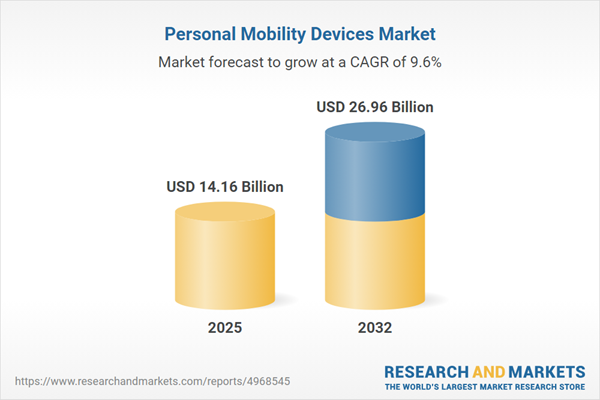Speak directly to the analyst to clarify any post sales queries you may have.
The personal mobility devices market is rapidly evolving, offering new solutions that empower individuals and respond to shifting healthcare needs. This report equips leaders with critical market perspectives and strategic frameworks to capitalize on emerging opportunities and address evolving challenges across the global value chain.
Market Snapshot: Personal Mobility Devices Market
The Personal Mobility Devices Market grew from USD 12.94 billion in 2024 to USD 14.16 billion in 2025. It is expected to continue growing at a CAGR of 9.61%, reaching USD 26.96 billion by 2032.
Scope & Segmentation
Stakeholders will benefit from clear visibility into essential product, user, technology, and geographical dimensions:
- Product Types: Mobility scooters, stair lifts, walking aids, manual wheelchairs, powered/electric wheelchairs.
- Technologies: Manual devices, powered devices.
- End Users: Disabled individuals, elderly populations, home care settings, hospitals and clinics, post-surgery patients, rehabilitation centers.
- Distribution Channels: Offline, online, including partnerships with hospitals, pharmacies, and specialty medical stores.
- Regions: Americas—including North America (United States, Canada, Mexico) and Latin America (Brazil, Argentina, Chile, Colombia, Peru); Europe, the Middle East & Africa—including mature European markets, Gulf Cooperation Council countries, and Africa (notably South Africa, Nigeria, Egypt, Kenya); and Asia-Pacific—including China, India, Japan, Australia, South Korea, Indonesia, Thailand, Malaysia, Singapore, and Taiwan.
- Key Companies: Xiaomi Corporation, Bird Rides, Inc., TIER Mobility GmbH, Voi Technology AB (publ), Gogoro Inc., Helbiz Inc., Razor USA LLC, Unagi Scooters, Inc., Ottobock SE & Co. KGaA, Permobil AB.
Key Takeaways for Market Leaders
- Market transformation is driven by population aging, increases in mobility impairment, and technological breakthroughs integrating smart functionalities and remote health monitoring.
- Product innovation is accelerating, with modular and digital features enhancing adaptability for clinical and home environments. Smart sensors and analytics contribute to user safety, enable real-time performance monitoring, and support proactive maintenance.
- Stakeholder collaboration across clinicians, payers, caregivers, and manufacturers is vital for seamless implementation and improved user experience across varied care settings.
- Regulatory changes support increased cybersecurity and interoperability, signaling a more robust approval process and higher consumer trust through effective quality systems.
- Regional adoption patterns vary: North America leads in powered and telehealth-enabled devices, Europe and the Middle East drive demand through inclusion initiatives, and Asia-Pacific experiences rapid uptake fueled by urbanization and rising incomes.
- Innovative distribution strategies—including e-commerce and in-person customization—enhance access, while new materials and design-for-manufacturability approaches optimize cost and supply resilience.
Tariff Impact and Supply Chain Dynamics
Recent tariff measures in the United States have added cost layers to key components, requiring manufacturers to reconsider sourcing and operational strategies. Many are responding by localizing assembly, forming alliances with regional suppliers, and sourcing materials resilient to trade policy fluctuations. These actions not only address cost pressures, but also create opportunities for greater supply chain flexibility and potential access to government incentives.
Methodology & Data Sources
The depth of this report is a result of robust secondary research—covering industry journals, regulatory documents, and patents—complemented by primary insights from interviews with clinicians, supply chain leaders, and design engineers. Segmentation and regional analyses were validated through direct expert engagements, ensuring reliable data triangulation and high value for senior decision-makers.
Why This Report Matters
- Enables executives to identify high-potential niches and shape product pipelines aligned with technology and policy trends in the personal mobility devices market.
- Supports strategic planning through actionable segmentation, regional analysis, and channel optimization insights.
- Provides a validated foundation for investment, partnership, and operational decisions sensitive to shifting regulatory and supply dynamics.
Conclusion
With rapid innovation and evolving user needs, the personal mobility devices market presents significant strategic opportunities. In-depth, data-driven insights will empower business leaders to drive growth, resilience, and differentiated value in this dynamic industry.
Additional Product Information:
- Purchase of this report includes 1 year online access with quarterly updates.
- This report can be updated on request. Please contact our Customer Experience team using the Ask a Question widget on our website.
Table of Contents
3. Executive Summary
4. Market Overview
7. Cumulative Impact of Artificial Intelligence 2025
Companies Mentioned
The companies profiled in this Personal Mobility Devices market report include:- Xiaomi Corporation
- Bird Rides, Inc.
- TIER Mobility GmbH
- Voi Technology AB (publ)
- Gogoro Inc.
- Helbiz Inc.
- Razor USA LLC
- Unagi Scooters, Inc.
- Ottobock SE & Co. KGaA
- Permobil AB
Table Information
| Report Attribute | Details |
|---|---|
| No. of Pages | 182 |
| Published | October 2025 |
| Forecast Period | 2025 - 2032 |
| Estimated Market Value ( USD | $ 14.16 Billion |
| Forecasted Market Value ( USD | $ 26.96 Billion |
| Compound Annual Growth Rate | 9.6% |
| Regions Covered | Global |
| No. of Companies Mentioned | 11 |









